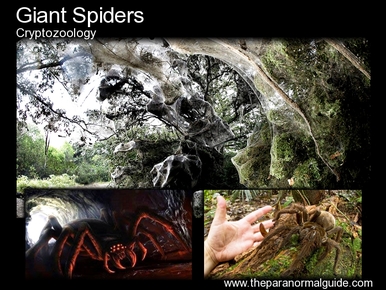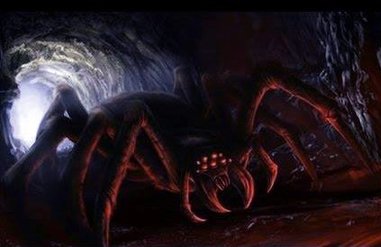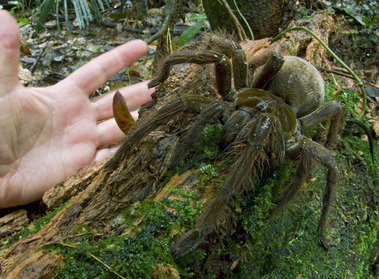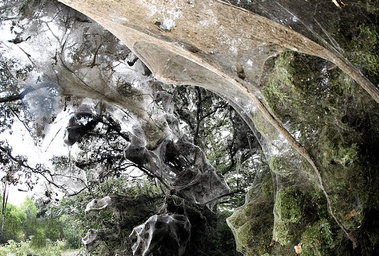
Are these monsters freaks of nature, a species thought to be extinct or works of wild imaginations?
Eight Legged Freaks!
 Illustration of Giant Spider.
Illustration of Giant Spider. With spiders being perhaps one of the most feared creatures on the planet, it was pure genius by King to make the villain of the story an arachnid of giant size. (My apologies to anyone who has not read the book or seen the 1990 TV movie starring Tim Curry as the evil Pennywise.)
This is one example of fiction in which the spider is used in a horror story and plays upon the common fear of arachnids: Arachnophobia. Spiders have appeared in the genres of fantasy - such as characters in the Harry Potter and Lord of the Rings series of books and films, and in graphic novels, with the tales of Spiderman, a superhero bitten by a radioactive spider and acquires arachnid abilities. Interestingly, radiation and spiders seem to be a popular coupling in science fiction films starting from the 1950's, depicting spiders being exposed to radiation/nuclear waste and growing in size.
Since ancient times spiders have had their place in many mythologies and are associated with many Gods, especially the tragic tale of Arachne, who angered the Greek goddess Athena. Even in nursery rhymes and children tales such as Itsy Bitsy Spider and Little Miss Muffet, the spider has a starring role. These creatures also feature in many philosophies, religions and folklore.
 Gargantuan Bird Eating Tarantula... thought to be one of the biggest known species.
Gargantuan Bird Eating Tarantula... thought to be one of the biggest known species. Around the globe reports have been made by people who claim to have had encounters with spiders that seem to defy any known species - spiders of a huge size that in some cases seem to be as large as a human being. Most of these reports seem to have come from Africa, and a cryptid by the name of J'Ba Fofi (Giant Spider) or the Congolese Giant Spider is considered to be the creature many have seen. Said to inhabit the Congo region, it is said to be a very large version of tarantula, with a hairy, brownish coloured body. It is said to have a leg span of 4 to 6 feet.
The Baka people who live in various areas of Cameroon and Gabon, have in modern times described this creature to Western explorers as living in deep holes in the ground and weaving circular webs between trees. English researcher William Gibbons, most known for researching claims of Mokele-Mbembe (a dinosaur said to still exist in the Congo) was apparently told in the 1990's a story by a Miss Maurgurite Lloyd, who claimed that in 1938 her parents, avid explorers, were driving a truck on a trail along the Congo when a creature walked slowly in front of them crossing the trail. They thought at first it was a large monkey on all fours, or possibly a jungle cat, but as they got closer they made out "something like a tarantula, with a 4-5 foot leg span". Before Reginald Lloyd could grab his camera, the creature scurried into nearby forest. Many explorers and game hunters are said to have had encounters with similar creatures, but had a tendency not to report them for fear of ridicule.
There is evidence to suggest that possibly these creatures may at one time have existed, as biologists now know that crocodile-sized sea scorpions called Jaekelopterus rhenaniae existed 390 million years ago, that measured up to 8-9 feet in length. It is one of two large species of anthropod to have been discovered by fossil remains (the other being a giant millipede-like animal), and it is theorised that It ate large fish and was capable of cannibalism.
Could a large version of prehistoric spider have survived to this day and be the cause of fear and anxiety to native tribes in Africa?
However, reports don't belong fully to the African continent.
 Really, really, really, large webs.
Really, really, really, large webs. Many arachnologists and biologists are sceptical about accounts of large spiders, believing that due to the poor circulatory systems most species of spiders have, the current air supply of oxygen would not allow a monster-sized spider to have enough oxygen to survive. However, there are many cryptozoologists and some biologists that argue that J'Ba Fofi, or creatures like it could be some kind of mutant species that may have more-evolved circulatory systems and are possibly more intelligent. These claims have been met by many in the biological community with ridicule and scorn. New species of spider are, however, being found every month in jungles and rainforests, with still much research to be done.
Spiders, in the view of many, are regarded with fear and dread, even though many spider experts believe they “are more afraid of us than we are of them".
However, will there come a day when a large species of spider is discovered, one that verifies these reports from all around the world?





 RSS Feed
RSS Feed
